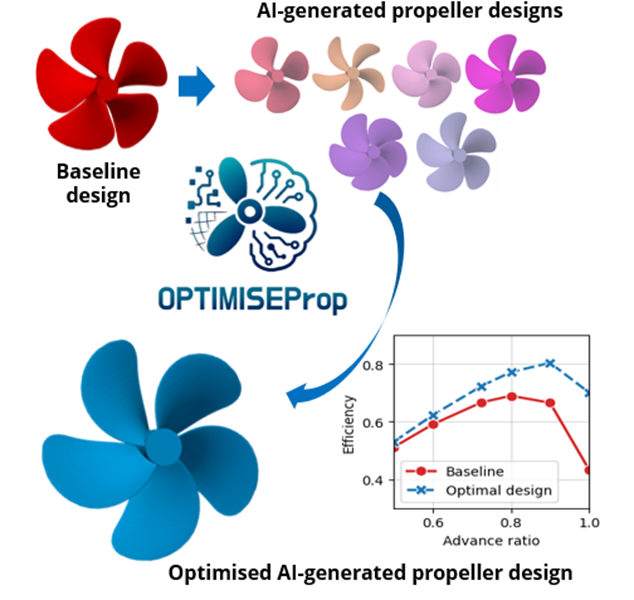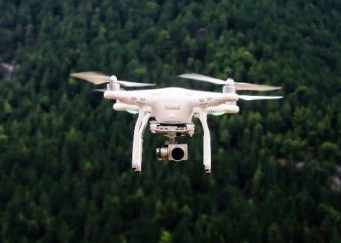Traditional marine propeller design relies on manual methods and expert experience. While effective, this approach can be time-consuming and limits exploration of potentially better designs due to the effort required for each iteration.
The OPTIMISEProp project addresses these challenges by introducing an automated design pipeline that integrates artificial intelligence and performance optimisation. By doing so, it enables faster, more accurate decision-making and improves the overall quality and efficiency of the design process. This data-informed, AI-driven approach enhances not only the performance of marine propulsion systems but also the competitiveness of Singapore’s maritime innovation ecosystem.
A*STAR IHPC collaborated closely with Mencast, a leading marine and offshore engineering group in Singapore. Their deep industry knowledge and real-world operating data were instrumental in shaping a design framework that is both technically robust and commercially viable.
The OPTIMISEProp framework combines machine learning, design optimisation, and high-fidelity simulation in a single end-to-end toolchain that transforms conventional propeller design workflows:
- AI-Based Shape Generation: The framework uses machine learning algorithms to generate novel propeller geometries that go beyond traditional design methods.
- Multi-Objective Optimisation: Advanced optimisation methods are applied to refine the designs based on performance indicators such as thrust, torque, cavitation risk, and fuel efficiency.
- High-Fidelity Computational Fluid Dynamics (CFD) Simulations: Each proposed design is evaluated using CFD simulations under realistic operating conditions, delivering precise insights into hydrodynamic performance.
These innovations have yielded five Technology Disclosures (TDs), three of which are currently under consideration by Mencast for commercial licensing. The result is a design tool that not only advances research but also holds strong potential to be used in real-world applications.
HPC resources from NSCC Singapore were pivotal to the project’s AI model training and large-scale simulation.
- Parallel CFD Simulations: NSCC Singapore’s HPC systems enabled the team to run hundreds of CFD simulations in parallel, dramatically reducing evaluation times and allowing a broader exploration of design possibilities.
- Accelerated AI Training: With access to large GPU clusters and high-memory compute nodes, the team was able to train and validate AI models efficiently, improving their accuracy and effectiveness. This led to a leap in efficiency—from 20 design iterations every few weeks to over 10,000 in a matter of days—vastly accelerating the pace of exploration and unlocking a wider pool of high-performance, sustainable designs.
- Scalable Optimisation Workflows: The computational scale provided by NSCC Singapore allowed simultaneous testing of multiple design variants, significantly compressing the design-to-evaluation cycle.
These capabilities were essential to achieving the speed, resolution, and complexity required to bring OPTIMISEProp to maturity. Prior to the project, propeller design was often limited by the number of iterations that could be realistically tested. By embedding AI-driven algorithms into Mencast’s parametric modelling and CFD tools, the team was able to rapidly generate and evaluate thousands of design variants with minimal manual input—streamlining the workflow and no more reliance on trial-and-error methods.
Although developed for maritime applications, the technologies and methodologies underpinning OPTIMISEProp are widely applicable. The framework’s ability to combine AI-driven design with advanced simulation has clear relevance in other engineering fields where fluid dynamics and performance optimisation are critical—such as aerospace, automotive, renewable energy, and even ship hull design.
By enabling more efficient propulsion systems, the project supports the maritime sector’s transition toward lower emissions and energy use, contributing to global climate goals. Furthermore, the integration of deep tech into a traditionally conservative domain opens new career pathways and invites cross-disciplinary talent to participate in maritime innovation—building a digitally empowered and sustainability-focused ecosystem.
For Mencast, this collaboration has been transformative. The release of OPTIMISE-Prop has significantly enhanced their design and engineering workflows by enabling engineers to independently generate and optimize propeller designs—either from scratch or based on an existing baseline. This capability allows the entire process to be completed within a day, accelerating turnaround times and empowering the team to focus on higher-level innovation and decision-making.
The impact of OPTIMISEProp is expected to unfold progressively over time. In the short term, efforts are centred on validating the framework and piloting its use with industry partners such as Mencast. Over the next few years, broader adoption is anticipated among local marine manufacturers and engineering firms. As AI-enhanced design tools become more integrated into standard engineering workflows, OPTIMISEProp has the potential to accelerate design processes, improve sustainability outcomes, and support cost-effective innovation across multiple sectors—contributing to both environmental goals and long-term economic growth.
“Our research leverages advanced AI and high-performance computing to rethink propeller design—enabling more energy-efficient propulsion systems that are essential for reducing maritime emissions. The collaboration with Mencast brought valuable real-world insight, while NSCC Singapore’s HPC infrastructure was critical in expanding the design space, training models, and running high-fidelity simulations. This project not only addresses decarbonisation needs, but älso lays the foundation for next-generation design tools that can transform engineering practices across sectors.”

Dr XING Xiuqing
Senior Principal Scientist, Group Manager
A*STAR IHPC






